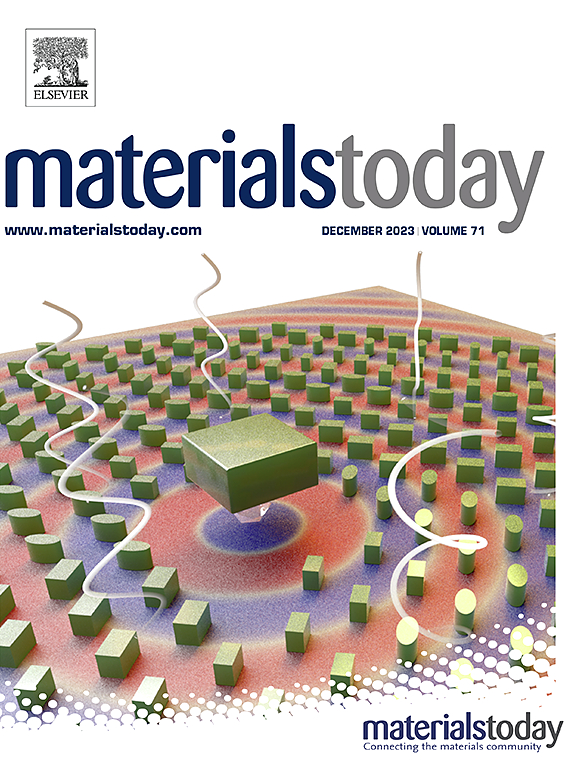Fe single atom trigger asymmetric In-In polarized site pairs boosting near-infrared N2 photoreduction
IF 21.1
1区 材料科学
Q1 MATERIALS SCIENCE, MULTIDISCIPLINARY
引用次数: 0
Abstract
Building differentiated charge distributed polarized atomic pairs may be an alternative for N2 activation. In this work, CuInS2 atomic layers with asymmetric In-In polarized site pairs are prepared by doping Fe single atoms, as proved by X-ray absorption fine structure spectroscopy, quasi in situ X-ray photoelectron spectra and calculated atomic charge distribution. The engineered Fe single atoms tuned the surface atomic charge distribution, building local polarization center to boost directional surface charge separation. The formed In-In polarized site pairs with asymmetric charge distribution creates distinct interaction with two N atoms in N2 molecule, contributing to the enhanced activation of N2. The alternating pathway is regarded as hydrogenation pathway over Fe-CuInS2 with *NNH formation as rate-determining step. The charge-redistributed surface atomic structure after engineered Fe single atoms strengthens intermediate interaction and lower the rate-determining step energy barrier. Benefiting from these features, Fe-CuInS2 exhibits excellent photocatalytic activity under near-infrared (NIR) irradiation with an ammonia synthesis rate of 94.1 μmol g−1 h−1. In comparison, the N2-NH3 conversion rate of Fe-CuInS2 under ultraviolet–visible (UV–Vis) irradiation could reach 137.4 μmol g−1 h−1, which is about 6.8 times higher than that of CuInS2. The apparent quantum efficiencies of Fe-CuInS2-2 at 380, 400, 450, 500, 550, 650, 700, 800, 850 and 1064 nm were 3.0 %, 3.3 %, 2.7 %, 2.1 %, 2.0 %, 1.5 %, 1.3 %, 0.4 %, 0.7 % and 0.6 %, respectively.
铁单原子触发不对称In-In极化位对,促进近红外N2光还原
构建分化电荷分布极化原子对可能是N2活化的替代方法。本文通过x射线吸收精细结构光谱、准原位x射线光电子能谱和计算的原子电荷分布证明,通过掺杂Fe单原子制备了具有不对称In-In极化位对的CuInS2原子层。工程铁单原子调整表面原子电荷分布,建立局部极化中心,促进定向表面电荷分离。形成的电荷分布不对称的in - in极化位点对与N2分子中的两个N原子产生明显的相互作用,促进了N2的活化。交替途径被认为是Fe-CuInS2上的加氢途径,以*NNH形成为速率决定步骤。经过工程处理的铁单原子的电荷重分布表面原子结构增强了中间相互作用,降低了决定速率的阶跃能垒。利用这些特性,Fe-CuInS2在近红外(NIR)照射下表现出优异的光催化活性,氨合成速率为94.1 μmol g−1 h−1。在紫外-可见(UV-Vis)照射下,Fe-CuInS2的N2-NH3转化率可达137.4 μmol g−1 h−1,是CuInS2的6.8倍。Fe-CuInS2-2在380、400、450、500、550、650、700、800、850和1064 nm处的表观量子效率分别为3.0%、3.3%、2.7%、2.1%、2.0%、1.5%、1.3%、0.4%、0.7%和0.6%。
本文章由计算机程序翻译,如有差异,请以英文原文为准。
求助全文
约1分钟内获得全文
求助全文
来源期刊

Materials Today
工程技术-材料科学:综合
CiteScore
36.30
自引率
1.20%
发文量
237
审稿时长
23 days
期刊介绍:
Materials Today is the leading journal in the Materials Today family, focusing on the latest and most impactful work in the materials science community. With a reputation for excellence in news and reviews, the journal has now expanded its coverage to include original research and aims to be at the forefront of the field.
We welcome comprehensive articles, short communications, and review articles from established leaders in the rapidly evolving fields of materials science and related disciplines. We strive to provide authors with rigorous peer review, fast publication, and maximum exposure for their work. While we only accept the most significant manuscripts, our speedy evaluation process ensures that there are no unnecessary publication delays.
 求助内容:
求助内容: 应助结果提醒方式:
应助结果提醒方式:


